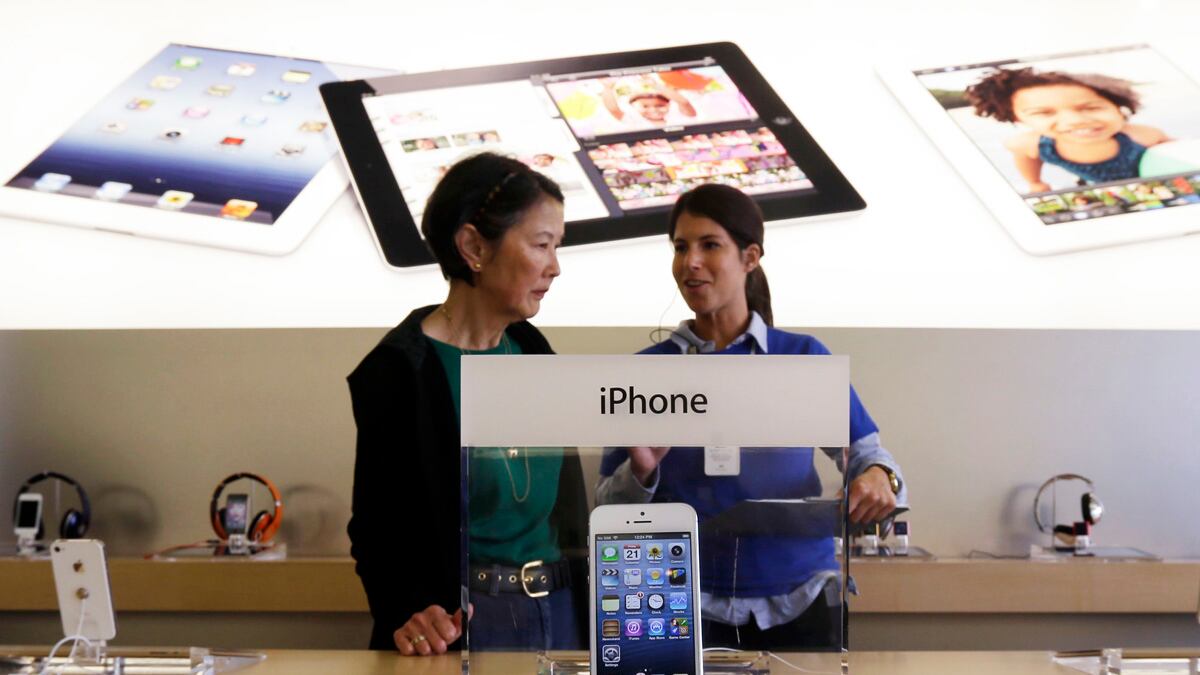So, listen. I’m not really interested in your new iPhone 5—whether it works, what the deal is with the maps application, how long you’re going to have to wait to get one, and how annoyed you are that you’ll have to buy a new charger. And I’m especially not interested in the photo you just took of it and posted on Instagram. This is a piece of electronics, a bunch of plastic and metal—not a dog, or a child, or a celebrity. (Though you’d think, from the velvet ropes at the entrance to the Apple store in Grand Central Station, that the iPhone5 is a celebrity.)
Of course, it has been a huge financial hit. And Apple—one of the most valuable companies in the world and a commercial ecosystem unto itself—is a huge and vital economic force. In fact, some iFans have been touting the iPhone as a form of stimulus on the scale of the Tennessee Valley Authority. It’s poised to sell 10 million units in the next few months. Let’s say the average consumer buys a $299 iPhone 5, that’s about $3 billion in sales.
The utility of stimulus is that it gets capital that would otherwise lie fallow, resting in a bank somewhere, and puts it to work in the economy. And by that measure, the iPhone 5 is stimulative. The billions of dollars in sales that the iPhone generates will translate into more hours for Apple’s employees, more work for the people who ship and deliver the goods, and more work for the already overworked, underpaid employees at Apple contractors in China. Since the iPhone5 is slightly bigger than the iPhone 4 and requires a different adapter, it also will bring about a flood of sales for accessory makers.
But as stimulus goes, the I-stimulus strikes me as a pretty narcissistic and ephemeral one. It would be one thing if the iPhone 5 allowed people to work or communicate in a fundamentally different way. But as all the reviewers have noted, the iPhone 5 represents incremental change rather than a revolutionary one. Will all the people who have them be more productive now that they’ve upgraded? It’s doubtful.
This money could do a lot more work closer to home. Imagine the flood of money unleashed by all the people lining up at Apple stores around the world were channeled into other areas. The money spent on 100 iPhones could pay down $30,000 on the balance of someone’s underwater mortgage—thus allowing the homeowner to refinance at a much lower rate and free up more cash to spend for years to come. On Kickstarter, there are dozens of projects itching to get off the ground for want of a few thousand dollars. Or you could deposit it in a community development bank, which would lend it out to people who need capital. Are you more globally minded? Check out Kiva. For the price of an iPhone 5, you could help a vendor in Liberia buy more palm oil and pepper for her stand—and get paid back with interest. You could buy some potholders on Etsy, or blow the cash at a farm stand. That money is guaranteed to be spent locally and quickly.

Now imagine if a bunch of high-income urbanites were to pool their collective capital and devote it to a useful initiative that would really increase productivity and improve the quality of life for themselves and for their fellow citizens—my pet projects would include wiring up Metro North trains with effective Internet access, or investing in energy efficiency programs in public buildings.
I understand that the money blown on iPhones comes from a different bucket than charity, or food—and that for many people a phone is a productivity-enhancing tool for work. But the frenzy over the iPhone 5 suggests to me that it’s yet another example of competitive consumption of a good that is designed to be obsolete before the warranty expires.
I’m no i-Phobe. In our house, we have a Mac desktop, a Macbook Air, two iPads, three iPhones, four iPods, and a Macintosh computer I bought in the fall of 1990. But when it comes to technology, I’m a firm believer in the good-enough. I understand Moore’s Law. I wouldn’t want to work on that 1990 Macintosh (and its 1,200-baud modem), or communicate with the brick-sized Motorola cell phone I bought in 1993. But my iPhone 4 doesn’t make me any cooler, or younger, or a better writer than I was when I relied on a BlackBerry. It’s more than good enough. And it seems like it should be enough to get me—and all those people waiting on long lines and tweeting pictures of their new device—at least through next June.




